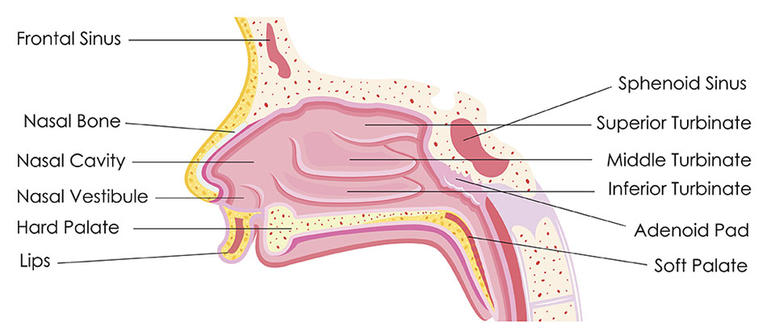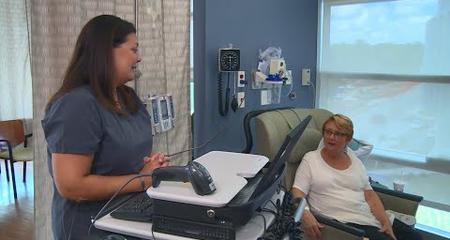The paranasal sinuses are hollow spaces surrounding the nose (nasal cavity) and eyes. The skull base is the boney structure behind the eyes and nose that separates the brain from the other facial structures. Tumors can involve these structures, as well as the eyes, nose, face and roof of the mouth.

Sinus and skull base cancers are relatively rare and highly complex. Each patient requires an individualized treatment approach delivered by a team of highly experienced, multidisciplinary team. Types of cancers that can be found in these areas include:
- Squamous cell carcinoma — most common type
- Sinonasal undifferentiated carcinoma
- Esthesioneuroblastoma
- Adenoid cystic carcinoma or acinic cell carcinoma
- Chondrosarcoma
- Chordoma
- Inverted papilloma
- Lymphoma
Sinus, Nasal and Skull-Base Cancer Symptoms
- Nosebleeds
- Sinus problems — facial pressure/pain, nasal drainage, nasal blockage
- Vision changes
- Non-healing sore on the roof of the mouth
- Facial contour changes
- Facial numbness or tingling
- Dental pain or loose teeth
- Headaches
Risk Factors
Exposure to relatively rare workplace chemicals or particulate matter in some cases may increase the risk for paranasal sinus and skull base cancers. At-risk occupations include carpentry, shoemaking, metal-plating and flour milling. The risk is also higher in people infected with human papillomavirus (HPV) and in men older than 40 who smoke.
Diagnosis
As part of the initial visit, the following tests may be used to detect, diagnose and/or stage a sinus, nasal or skull base cancer.
- Discussion of current symptoms, past medical history, and health habits
- Physical examination: an exam to check the eyes, nose, face, mouth and neck
- Endoscopy: a slender camera may be used after appropriate numbing through the nose to look into the nasal cavity and/or paranasal sinuses
- Biopsy: to obtain a definitive diagnosis, which may require a brief outpatient trip to the operating room
- Imaging: may include CT scan, MRI and/or PET scan
Treatment Options
Depending on the type, extent and location of the tumor, patients may require surgery, radiation therapy and/or chemotherapy or a combination of these treatments. Surgical options often include minimally invasive endoscopic surgery with image guidance that is carried out through the nose with no visible incisions. Other options may include highly specialized radiation treatments such IMRT (intensity-modulated radiation therapy), TomoTherapy® and/or Gamma Knife®. Our multidisciplinary team has the ability to offer all of these treatment options with the experience and expertise to help guide patients through this complex care.
During and after treatment, the Head and Neck Cancer Program’s team of speech-language pathologists, physical and occupational therapists, audiologists, dietitians and other supportive care specialists provide patients with individualized, best-practice therapy and rehabilitation These skilled members of our multidisciplinary team help to ensure patients achieve the best functional outcomes possible. Additionally, patients have access to the varied patient support resources available.
Treatment Team
We have a collaborative team of highly skilled specialists with experience in treating patients with challenging cases of paranasal sinus and skull base cancers. Members of your treatment team may include:
- Otolaryngologists, including head and neck oncologic surgeons and rhinologists/skull base surgeons
- Neurosurgons
- Radiation oncologists
- Medical oncologists
- Neurologists
- Interventional neuroradiologists
- Oculoplastic surgeons
Sinus, Nasal and Skull-Base Cancer - Video FAQ
Joseph Zenga, MD, head and neck surgical oncologist, explains nasal cavity and anterior skull-base cancers.
Nasal cavity and anterior skull-base cancers are cancers that originate, actually, in the sinuses. They can either be in the sinuses behind the cheeks or in the sinuses between the eyes, but ultimately they are a cancer that comes from the lining of the sinuses.
Those cancers, again in early stages, are easily treated with surgery and sometimes radiation therapy. As you can imagine, it is a high real estate area. There are important things there. The eyes are there and the eye muscles. And the brain is not far away. There is a thin plate of bone that separates the sinuses from the lining of the brain and brain fluid right up between the eyes. When we are treating those cancers, we have to be very thoughtful about how we approach that in terms of removing the cancer and then how we rebuild that area safely and successfully to prevent any post-operative complications.
Joseph Zenga, MD, head and neck surgical oncologist, explains that symptoms of nasal cavity and anterior skull-base cancers vary based on where they originate.
The symptoms of nasal cavity and anterior skull-base cancers depend entirely on where these cancers originate in the sinuses, and what they are doing and how big they are. As you can imagine, if they are growing and putting pressure on the eye you could have vision changes in one or both eyes. There are important nerves around the skull base, around the sinuses and particularly the nerves that give sensation to the face, so you may actually have facial numbness on one side or the other depending on how and where these cancers grow. Also, the mucous membranes can become irritated or ulcerated from the cancers, so you may have nosebleeds that get worse over time.
Joseph Zenga, MD, head and neck surgical oncologist, lists the specialists who are part of the experienced team when dealing with nasal cavity and skull-base cancers.
It is critical to go to an experienced team when dealing with nasal cavity and skull-base cancers because, number one, they are rare. And, number two, it is really high stakes. We need to be very precise, very thoughtful and very experienced about approaching treatment in a multidisciplinary fashion.
Our skull-base team has a reconstructive surgeon, an ENT surgeon who can approach the sinuses and get exposure to those cancers and a skull-base neurosurgeon who has extensive experience in operating around the skull base and around the lining of the brain. One, gets that cancer out as completely as possible. And, two, allows that patient to be reconstructed and healed in the quickest and most minimally invasive way possible.
Joseph Zenga, MD, head and neck surgical oncologist, explains that treatment for nasal cavity and anterior skull-base cancers.
The treatment for nasal cavity and anterior skull-base cancers depends entirely on what type of cancer it is and how extensive that cancer is involving those areas. Some cancers are treated with chemotherapy and radiation and do not require surgery. Other cancers require surgery, and typically it is a surgery that is done before any other treatments.
Most of the time, we are able to successfully remove and rebuild the anterior skull-base cancers through the nose. We use camera scopes that go through the nostrils, as well as surgical instruments for fully minimally invasive access that gets rid of that cancer. In some situations, we need to have a larger exposure to successfully cure that disease and and get rid of all that cancer. Those situations sometimes require incisions in the face, but we're able to hide those in creases around the nose or on the eyelid. That allows us to get the right exposure to get the best cancer control, while at the same time achieving a really excellent cosmetic outcome for that patient.
Virtual Visits Are Available
Safe and convenient virtual visits by video let you get the care you need via a mobile device, tablet or computer wherever you are. We’ll gather your medical records for you and get our experts’ input so we can offer treatment options without an in-person visit. To schedule a virtual visit, call 1-866-680-0505.
Recognized as High Performing by U.S. News & World Report
Froedtert Hospital is recognized by U.S. News & World Report as high performing in three adult specialties and 16 procedures and conditions, including cancer.




